The isosceles trapezoid is, in fact, a trapezoid (that is, a four-sided polygon with two of them - the bases - being parallel), with two of its sides being equivalent and with its base angles of equal magnitude.
Isosceles Trapezoid
Isosceles Trapezoid
In the trapezoid, as is known, there are two bases and, each base has two base angles adjacent on both sides. In other words, in the isosceles trapezoid, there are two sets of equal base angles, as can be seen in the following illustration:
Isosceles Trapezoid
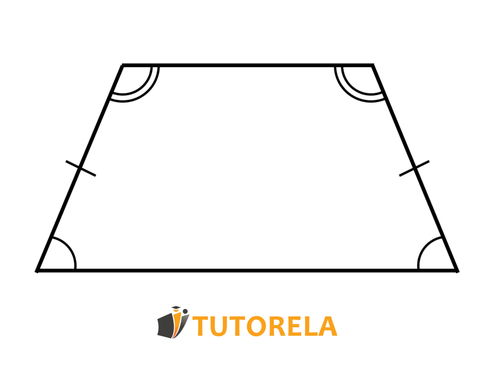
Test yourself on isosceles trapezoids!
Do isosceles trapezoids have two pairs of parallel sides?
Definition of an isosceles trapezoid
The isosceles trapezoid is, in fact, a trapezoid (that is, a four-sided polygon with two of them - the bases - being parallel), with two of its sides being equivalent and with its base angles of equal magnitude.
In the trapezoid, as is known, there are two bases and, each base has two adjacent base angles on both sides. In other words, in the isosceles trapezoid, there are two sets of equal base angles, as can be seen in the following illustration:
Isosceles Trapezoid

Isosceles Trapezoid Properties
The properties detailed here are the unique characteristics of isosceles trapezoids among all other types of trapezoids. The following illustration describes the theorems in the best way:
Properties of the Isosceles Trapezoid
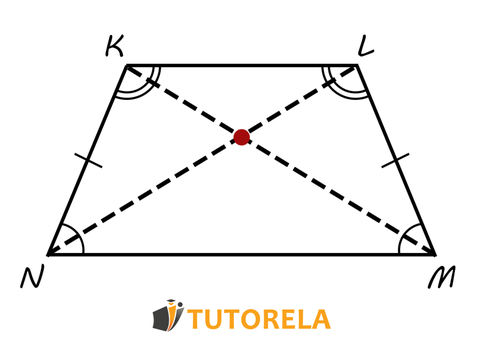
- The sides that are not parallel are congruent, that is, they have the same measure. That is, it is fulfilled:
- In the isosceles trapezoid, there are two sets of equal angles for the larger base and for the smaller base.
That is, angles and are equivalent, just like angles and are also.
- The two diagonals of the isosceles trapezoid are equal. That is, it is fulfilled:
- Any isosceles trapezoid can be inscribed in a circle
Below is an isosceles trapezoid
If \( ∢D=50° \)
Determine the value of \( ∢B \)?
Given: \( ∢A=120° \)
The isosceles trapezoid
Find a: \( ∢C \)
Given: \( ∢C=2x \)
\( ∢A=120° \)
isosceles trapezoid.
Find x.
Demonstration of the Isosceles Trapezoid
To demonstrate that a trapezoid is isosceles, we must make use of the properties specified earlier, in fact, these are reciprocal theorems. It is sufficient to demonstrate just one property.
That is, if we prove that:
- The two sides that are not parallel are congruent
or
- The angles at the base of the trapezoid are congruent
or
- The diagonals of the trapezoid are congruent
then, said trapezoid is an isosceles trapezoid.
The diagonals of an isosceles trapezoid
The following properties refer to the diagonals of the isosceles trapezoid. To highlight these properties in the best way, we will use this illustration:
Diagonals of the Isosceles Trapezoid
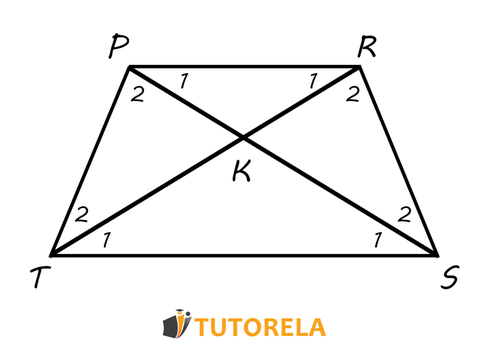
- The two diagonals are equal. That is, it holds that:
- The triangles and are congruent according to the side - side - side congruence theorem
- The triangles and are congruent according to the side - side - side congruence theorem
- The triangles and are isosceles triangles with all that this implies
- The angles , , , and are equivalent
True OR False:
In all isosceles trapezoids the base Angles are equal.
In an isosceles trapezoid, will the sum of the opposite angles always be 180°?
Are the diagonals of an isosceles trapezoid equal and do they intersect each other?
Calculation of the Area of an Isosceles Trapezoid
The calculation of the area of an isosceles trapezoid is done exactly in the same way as the area of any other trapezoid is calculated.
That is, the lengths of the two bases are added, the total sum is multiplied by the height, and then, it is divided by .
We will use this illustration to explain the steps of the calculation:
Finding the area of an Isosceles Trapezoid
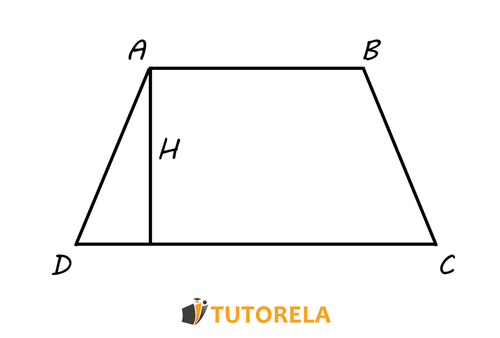
The formula to calculate the area of the isosceles trapezoid (not exclusively) is:
Examples and exercises with isosceles trapezoids
Exercise No 1
Given the isosceles trapezoid described in the following scheme.
It is known that the sum of three angles is degrees.
According to the data, we must calculate all the angles of this isosceles trapezoid.
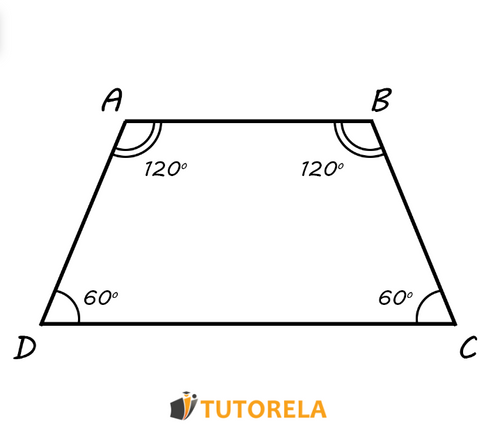
Solution:
If the sum of the three angles of the given trapezoid is and the total sum of the angles of a trapezoid (as with any quadrilateral) is , we can deduce that the fourth angle measures degrees.
It is one of the adjacent angles to the smaller base, let's assume angle . Since it is an isosceles trapezoid, the angles at the base are congruent, therefore, angle also measures .
Remember that it is a trapezoid and that the bases and are parallel, that is, angles and (just like and ) are collateral angles and, therefore, complement each other and together measure degrees. Therefore, it will give us that angles and measure degrees.
Answer:
The angles of the trapezoid are
Do the diagonals of the trapezoid necessarily bisect each other?
The perimeter of the trapezoid equals 22 cm.
AB = 7 cm
AC = 3 cm
BD = 3 cm
What is the length of side CD?
Look at the polygon in the diagram.
What type of shape is it?
Exercise No 2
Given the isosceles trapezoid described in the following scheme.
It is known that the sum of two of its sides is .
According to the data, we must calculate all the angles of this isosceles trapezoid.
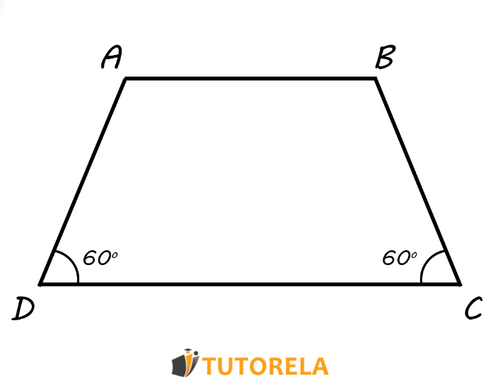
Solution:
Let's go back to the rules related to the base and remember that it is a trapezoid and that the bases and are parallel, that is, the angles and (as well as and ) are collateral angles and, therefore, complement each other and together measure degrees. Given that the amplitude we have is degrees, we can deduce that these are not adjacent angles on the same side (i.e., unilateral), but angles that share the same base.
Being an isosceles trapezoid, the base angles are congruent, therefore, each of them measures degrees.
The complementary angle (to reach degrees) of each of these angles measures degrees.
Answer:
The angles of the trapezoid are
Examples and exercises with solutions of isosceles trapezoid
Exercise #1
Do isosceles trapezoids have two pairs of parallel sides?
Step-by-Step Solution
To solve this problem, we'll follow these steps:
- Step 1: Define the geometric properties of a trapezoid.
- Step 2: Define the geometric properties of an isosceles trapezoid.
- Step 3: Conclude whether an isosceles trapezoid has two pairs of parallel sides based on these definitions.
Now, let's work through each step:
Step 1: A trapezoid is defined as a quadrilateral with at least one pair of parallel sides.
Step 2: An isosceles trapezoid is a special type of trapezoid where the non-parallel sides (legs) are of equal length. Its defining feature is having exactly one pair of parallel sides, which is the same characteristic as a general trapezoid.
Step 3: Since the definition of a trapezoid inherently allows for only one pair of parallel sides, an isosceles trapezoid, as a type of trapezoid, cannot have two pairs of parallel sides. A quadrilateral with two pairs of parallel sides is typically designated as a parallelogram, not a trapezoid.
Therefore, the solution to the problem is that isosceles trapezoids do not have two pairs of parallel sides. No.
Answer
No
Exercise #2
Below is an isosceles trapezoid
If
Determine the value of ?
Video Solution
Step-by-Step Solution
Let's recall that in an isosceles trapezoid, the sum of the two angles on each of the trapezoid's legs equals 180 degrees.
In other words:
Since angle D is known to us, we can calculate:
Answer
130°
Exercise #3
Given:
isosceles trapezoid.
Find x.
Video Solution
Step-by-Step Solution
Given that the trapezoid is isosceles and the angles on both sides are equal, it can be argued that:
We know that the sum of the angles of a quadrilateral is 360 degrees.
Therefore we can create the formula:
We replace according to the existing data:
We divide the two sections by 4:
Answer
30°
Exercise #4
True OR False:
In all isosceles trapezoids the base Angles are equal.
Video Solution
Step-by-Step Solution
True: in every isosceles trapezoid the base angles are equal to each other.
Answer
True
Exercise #5
In an isosceles trapezoid, will the sum of the opposite angles always be 180°?
Step-by-Step Solution
Let's closely examine the properties of an isosceles trapezoid to determine the relationship between its opposite angles.
An isosceles trapezoid is a type of trapezoid where the non-parallel sides (legs) are of equal length. It also implies that the angles adjacent to each leg are equal, due to the symmetry of the trapezoid. However, the most crucial aspect for this problem involves understanding the sum of angles in a trapezoid and their specific relationships.
Consider an isosceles trapezoid, , with base parallel to base , and legs and being equal.
- The key property in any trapezoid is that each pair of angles on the same side of one of the non-parallel sides ( or ) are supplementary. That is, angles and together sum to since they are co-interior angles formed by a transversal cutting the parallel lines and .
- Similarly, angles and also sum to .
In addition, the total sum of the interior angles of any quadrilateral (and thus any trapezoid) is . Therefore, opposite angles and (first set) sum to , and similarly, opposite angles and (second set) also sum to . Therefore, the sum of the opposite angles in an isosceles trapezoid is always .
Thus, through application of the properties of parallel lines and angle sums, we find that the sum of opposite angles in an isosceles trapezoid is indeed always .
The correct conclusion of this problem is that the statement is True.
The sum of the opposite angles in an isosceles trapezoid is always .
Answer
True
In an isosceles trapezoid ABCD
\( ∢B=3x \)
\( ∢D=x \)
Calculate the size of angle \( ∢B \).
What do the diagonals in an isosceles trapezoid always form?
Given that: the perimeter of the trapezoid is equal to 75 cm
AB= X cm
AC= 15 cm
BD= 15 cm
CD= X+5 cm
Find the size of AB.
More Questions
Isosceles Trapezoids
- Area
- Trapezoids
- Symmetry in Trapezoids
- Area of a trapezoid
- Perimeter of a trapezoid
- Parallelogram
- Identifying a Parallelogram
- Rotational Symmetry in Parallelograms
- From the Quadrilateral to the Parallelogram
- Kite
- Rectangle
- From a Quadrilateral to a Rectangle
- From a Parallelogram to a Rectangle
- Midsegment
- Midsegment of a trapezoid
- Square
- Area of a square
- From Parallelogram to Square
- Rhombus, kite, or diamond?
- Diagonals of a Rhombus
- Lines of Symmetry in a Rhombus
- From Parallelogram to Rhombus
- The Area of a Rhombus
- Perimeter
- Areas of Polygons for 7th Grade
- Area of a right-angled trapezoid
- Area of an isosceles trapezoid
- How do we calculate the area of complex shapes?
- How do we calculate the perimeter of polygons?
- Diagonals in a rectangle
- Symmetry in a kite









